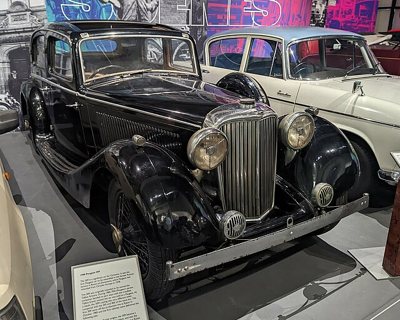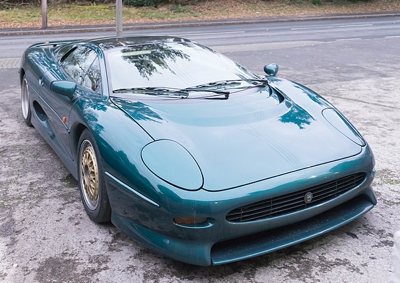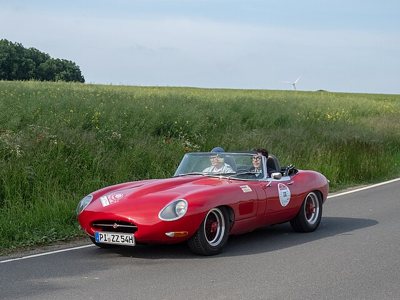When thinking about sleek, eye-candy cars that can outrun anyone on the road, the Jaguar isn't far from the conversation. Founded in 1922 as Swallow Sidecar Company that specializes in sidecars and passenger car bodies, the company eventually became known as Jaguar in 1933 with its first vehicle released to the public two years later.
Who Owns Jaguar Now?
Jaguar is owned by Tata Motors, an Indian multinational car manufacturing company. Tata Motors acquired Jaguar and Land Rover, from Ford in 2008 for £1.7 billion.
Jaguar's Early Years
 Jaguar, as a car manufacturer, didn't waste time developing cars that merely worked on the road. Their very first vehicle, the SS Jaguar 2.5L Saloon was an incredibly sleek vehicle with an already remarkably long body (186 inches) that would eventually become the standard look for many Jaguar cars. Its engine produced 102 horsepower with a top speed of 87 mph - a notable achievement considering the car was released in 1935.
Jaguar, as a car manufacturer, didn't waste time developing cars that merely worked on the road. Their very first vehicle, the SS Jaguar 2.5L Saloon was an incredibly sleek vehicle with an already remarkably long body (186 inches) that would eventually become the standard look for many Jaguar cars. Its engine produced 102 horsepower with a top speed of 87 mph - a notable achievement considering the car was released in 1935.
In 1936, Jaguar followed it up with the 1939 SS Jaguar 100. Regarded as one the most beautifully designed cars of the decade, it is easy to appreciate this two-seater with its long engine body. It is shorter compared to its predecessor in length and width (153 in/63 in) but they look incredible on the road even today. This model is incredibly rare because only 314 cars were made.
Conquering the Le Mans
Showing the world that their cars were not just incredibly great looking, Jaguar also established itself a powerhouse in the racing circuit during the 1950s. Their two iconic cars put Jaguar on the map as some of the best of its era.
 The Jaguar C-Type
The Jaguar C-Type
Also known as the Jaguar XK120-C, is a roadster-type racing vehicle. Its Le Mans-winning version was powered by a 3.4-liter Straight-Six DOHC Engine with 220 horsepower. It also featured an aluminum body, which contributed to its lightweight design, and innovative air intake technology for enhanced power and efficiency. The C-Type won the Le Mans twice: in 1951 and 1953.
D-Type
However, Jaguar did not rest on its laurels with two wins. Jaguar participated with the D-Type in 1954 but was hampered by mechanical problems.
With modifications in 1955, Jaguar returned to its winning form in 1955 and again in 1956. The D-Type won again in 1957, making it an even more remarkable achievement considering that five of the top six finishers in the race also used the Jaguar D-Type.
Fast & Beautiful
 During the 90s, Jaguar achieved significant success with its sleek and fast vehicles. A prime example is the two-seater Jaguar XJ220, the fastest car of its time. Powered by a 3.5 L Twin-Turbocharged Jaguar JRV-6 V6 Engine, this car is incredibly fast with a top speed of 212 mph. Jaguar successfully created a speedy and roadworthy car that also looks incredible. The silver-colored, two-door coupe exudes a sleek, high-performance aesthetic.
During the 90s, Jaguar achieved significant success with its sleek and fast vehicles. A prime example is the two-seater Jaguar XJ220, the fastest car of its time. Powered by a 3.5 L Twin-Turbocharged Jaguar JRV-6 V6 Engine, this car is incredibly fast with a top speed of 212 mph. Jaguar successfully created a speedy and roadworthy car that also looks incredible. The silver-colored, two-door coupe exudes a sleek, high-performance aesthetic.
While the XJ220 is a powerful car designed to push limits on the road, the XK series is built to cater to those looking for a more practical use of their vehicle. Its original design, the XK8, was released in 1996 and comes with a two-door coupe and convertible, both seating four, including the driver. Fortunately, the XK8 and its future iterations retained the classic and unmistakable Jaguar design.
Size-wise, the XJ220 measures 194.1 inches in length and 79.1 inches in width, while the XK8 is slightly shorter at 187.4 inches/72.0 inches. Although the XJ220 is designed for speed, it's still larger and wider compared to the four-seater XK8.
Jaguar's Iconic Vehicles
Although Jaguar has built many fast, sleek and powerful cars, they have also built some iconic vehicles that have helped shaped the car industry today:
 Jaguar E-Type
Jaguar E-Type
Launched in 1961, the E-Type is widely considered one of the most beautiful cars of all time. Its impressive performance capabilities include a top speed of 150 mph.
XJ-S
After the success of the E-Type, this beautiful Grand Luxury Tourer came with a V12 engine that pushes its speed up to 155 mph.
Jaguar F-Type
Before Jaguar's transition to electric vehicles, the F-Type proudly carried on the classic Jaguar design tradition, boasting a Supercharged V8 engine with a top speed of up to 200 mph.
The Future
After the F-Type Jaguar is transitioning into becoming an all-electric vehicle manufacturer. They will be maintaining same standard of high performance vehicles but with electric powertrains. They are currently offering the Jaguar I-PACE a fully electric SUV and the EV version of Jaguar XJ is coming soon.
Conclusion
Jaguar's car sizes have varied over the years, from compact sports cars like the Jaguar E-Type, to larger luxury cars like the Mark IX. Today, they offer a range of size options, including compact cars, SUVs, and electric vehicles like the I-PACE.
